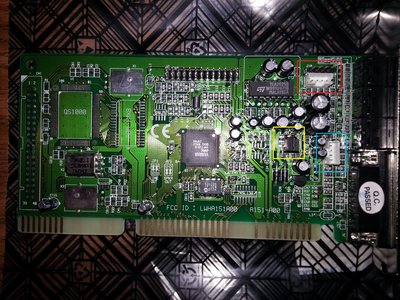First post, by Runicen
- Rank
- Newbie
This is a topic I know has been done to death on the forums, but I wanted to see if I could get something specific to my situation here and none of my searching turned up a scenario close enough to what I'm working with, so let's give it a whirl (and, by all means, if there's a thread that covers this stuff, please link me - I may have missed something).
For my purposes, we're looking at a range of gaming from early 90s to 97-ish (i.e. MS-DOS to early Win 98).
I'm running a P200 with 32mb of ram. Originally, I had a PCI Sound Blaster Audigy (1) that was gobbling up memory with its software SB16 emulation. And yes, I realize it wasn't a good match for that kind of gaming, but at the time I just wanted to "mock up" a working legacy system to see if I wanted to pursue the project any further. Of course, duh, I did - and so I picked up a Yamaha Audician 32 Plus based on a recommendation I read on here.
Unfortunately, the Yamaha has a really noisy output and the CD audio is a little dodgy in games that use redbook music playback like Little Big Adventure (or Relentless as I know it), so it's still not a perfect solution, though it may be one I'll return to.
I managed to score an SB16 Wave Effects (CT4520) ISA card, but found out AFTER getting it that it has no on-board synthesis capability, so for games like Little Big Adventure or even the ever-finicky Interplay Lord of the Rings (CD-Rom version), which use redbook music and digital sound effects, I'm golden; but Wolf3d becomes a Charlie Chaplin movie with it enabled.
So, here's my question: if I'm looking to either use what I have OR spend no more than $40, what are my options for maximum compatibility and quality output in an MS-DOS or Win 95/98 environment? Would I be better served just dropping ISA entirely and picking up a PCI Sound Blaster since those tend to run cheaper than their ISA cousins or would I just run into the same crap with noisy outputs?
At this point, should I just suck it up and go back to the Yamaha since it was doing the job with only some grit in the output? Or is there a way to slave a cheap but effective midi card or device to the SB16 to make that my ticket to ride?
Actually, along those lines, can the Yamaha be modified to "clean up" the signal in the absence of a straight line out jack?
Sorry for shotgunning questions, but hopefully someone can sort me out AND someone else with a similar issue can benefit from the answer.
Thanks in advance for the help (both past, present and future - this forum is a great resource).
